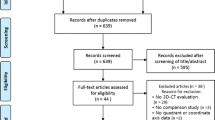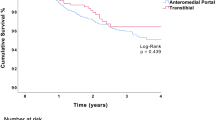Abstract
Purpose
Correct placement of the femoral and tibial tunnels in the anatomic footprint during anterior cruciate ligament reconstruction (ACLR) is paramount for restoring rotatory knee stability. Recent studies have looked at surgeon volume and its outcomes on procedures such as total knee arthroplasty and infection rates, but only few studies have specifically examined tunnel placement after ACLR based on surgeon volume. The purpose of this study was to compare the placement of femoral and tibial tunnels during ACLR between high-volume and low-volume surgeons. It was hypothesized that high-volume surgeons would have more anatomic tunnel placement compared with low-volume surgeons.
Methods
A retrospective review of all ACLR performed between 2015 and 2019 at an integrated health care system consisting of both academic and community hospitals with 68 orthopaedic surgeons was conducted. Surgeon volume was categorized as less than 35 ACLR per year (low volume) and 35 or more ACLR per year (high volume). Femoral tunnel placement for each patient was determined using an exact strict lateral radiograph (less than 6 mm of offset between the posterior halves of the medial and lateral condyles) taken after the primary ACLR using the quadrant method. The centre of the femoral tunnel was measured in relation to the posterior–anterior (PA) and proximal–distal (PD) dimensions (normal centre of anatomic footprint: PA 25% and PD 29%). Tibial tunnel placement for each patient was determined on the same lateral radiographs by measuring the mid-sagittal tibial diameter and the centre of the tibial attachment area of the ACL from the anterior tibial margin (normal centre of anatomic footprint: 43%). Each lateral radiograph was reviewed by one of two blinded reviewers.
Results
A total of 4500 patients were reviewed, of which 645 patients met all the inclusion/exclusion criteria and were included in the final analysis. There were 228 patients in the low-volume group and 417 patients in the high-volume group. Low-volume surgeons performed a mean of 5 ACLRs per year, whereas surgeons in the high-volume group performed a mean of 40 ACLRs per year. In the PA dimension, the low-volume group had significantly more anterior femoral tunnel placement compared with the high-volume group (32 ± 10% vs 28 ± 9%, p < 0.01). In the PD dimension, the low-volume group had statistically significant more proximal femoral tunnel placement compared to the high-volume group (32 ± 9% vs 35 ± 9%, p < 0.01). For the tibial tunnel, the low-volume group had significantly more posterior tibial tunnel placement compared with the high-volume group (41 ± 10% vs 38 ± 7%, p < 0.01).
Conclusion
Low-volume surgeons placed their femoral tunnels significantly more anterior and proximal (high) during ACLR, and placed their tibial tunnels significantly more posterior, compared with high-volume surgeons. Prior research has indicated that anatomic placement of the femoral and tibial tunnels during ACLR leads to improved rotatory knee stability. The findings of this study demonstrate the importance of surgical volume and experience during ACLR.
Level of evidence
III.


Similar content being viewed by others
References
Ahlden M, Samuelsson K, Sernert N, Forssblad M, Karlsson J, Kartus J (2012) The Swedish National Anterior Cruciate Ligament Register: a report on baseline variables and outcomes of surgery for almost 18,000 patients. Am J Sports Med 40:2230–2235
Annear PT, Rohr EJ, Hille DM, Gohil S, Ebert JR (2019) No clinical difference in 10-year outcomes between standard and minimal graft debridement techniques in patients undergoing anterior cruciate ligament reconstruction using autologous hamstrings: a randomized controlled trial. Knee Surg Sports Traumatol Arthrosc 27:516–523
Araujo PH, Asai S, Pinto M, Protta T, Middleton K, Linde-Rosen M et al (2015) ACL graft position affects in situ graft force following ACL reconstruction. J Bone Jt Surg Am 97:1767–1773
Behrend H, Stutz G, Kessler M, Rukavina A, Giesinger K, Kuster M (2006) Tunnel placement in anterior cruciate ligament (ACL) reconstruction: quality control in a teaching hospital. Knee Surg Sports Traumatol Arthrosc 14:1159–1165
Bernard M, Hertel P, Hornung H, Cierpinski T (1997) Femoral insertion of the ACL. Radiographic quadrant method. Am J Knee Surg 10:14–21
Byrne KJ, Hughes JD, Gibbs C, Vaswani R, Meredith SJ, Popchak A et al (2021) Non-anatomic tunnel position increases the risk of revision anterior cruciate ligament reconstruction. Knee Surg Sports Traumatol Arthrosc. https://doi.org/10.1007/s00167-021-06607-71-8
Conte EJ, Hyatt AE, Gatt CJ Jr, Dhawan A (2014) Hamstring autograft size can be predicted and is a potential risk factor for anterior cruciate ligament reconstruction failure. Arthroscopy 30:882–890
Eliya Y, Nawar K, Rothrauff BB, Lesniak BP, Musahl V (2020) Anatomical anterior cruciate ligament reconstruction (ACLR) results in fewer rates of atraumatic graft rupture, and higher rates of rotatory knee stability: a meta-analysis. JISAKOS 5:359–370
Fu FH, van Eck CF, Tashman S, Irrgang JJ, Moreland MS (2015) Anatomic anterior cruciate ligament reconstruction: a changing paradigm. Knee Surg Sports Traumatol Arthrosc 23:640–648
Group MK, Spindler KP, Huston LJ, Zajichek A, Reinke EK, Amendola A et al (2020) Anterior cruciate ligament reconstruction in high school and college-aged athletes: does autograft choice influence anterior cruciate ligament revision rates? Am J Sports Med 48:298–309
Harato K, Kobayashi S, Toyoda T, Hasegawa T, Tsukimura Y, Niki Y (2020) Technical obstacles for low-volume surgeons in primary anterior cruciate ligament reconstruction. J Knee Surg 33:1238–1242
Hoser C, Tecklenburg K, Kuenzel KH, Fink C (2005) Postoperative evaluation of femoral tunnel position in ACL reconstruction: plain radiography versus computed tomography. Knee Surg Sports Traumatol Arthrosc 13:256–262
Kaeding CC, Aros B, Pedroza A, Pifel E, Amendola A, Andrish JT et al (2011) Allograft versus autograft anterior cruciate ligament reconstruction: predictors of failure from a MOON prospective longitudinal cohort. Sports Health 3:73–81
Kaeding CC, Pedroza AD, Reinke EK, Huston LJ, Consortium M, Spindler KP (2015) Risk factors and predictors of subsequent ACL injury in either knee after ACL reconstruction: prospective analysis of 2488 primary ACL reconstructions from the MOON cohort. Am J Sports Med 43:1583–1590
Kato Y, Ingham SJ, Kramer S, Smolinski P, Saito A, Fu FH (2010) Effect of tunnel position for anatomic single-bundle ACL reconstruction on knee biomechanics in a porcine model. Knee Surg Sports Traumatol Arthrosc 18:2–10
Krych AJ, Jackson JD, Hoskin TL, Dahm DL (2008) A meta-analysis of patellar tendon autograft versus patellar tendon allograft in anterior cruciate ligament reconstruction. Arthroscopy 24:292–298
Li LT, Boskshan SL, DeFroda SF, Mehta SR, Fadale PD, Owens BD (2020) High case volume predicts greater odds of autograft use and meniscal repair for anterior cruciate ligament reconstruction. Arthroscopy. https://doi.org/10.1016/j.arthro.2020.08.011
Lyman S, Koulouvaris P, Sherman S, Do H, Mandl LA, Marx RG (2009) Epidemiology of anterior cruciate ligament reconstruction: trends, readmissions, and subsequent knee surgery. J Bone Jt Surg Am 91:2321–2328
Magnussen RA, Carey JL, Spindler KP (2011) Does autograft choice determine intermediate-term outcome of ACL reconstruction? Knee Surg Sports Traumatol Arthrosc 19:462–472
Magnussen RA, Lawrence JT, West RL, Toth AP, Taylor DC, Garrett WE (2012) Graft size and patient age are predictors of early revision after anterior cruciate ligament reconstruction with hamstring autograft. Arthroscopy 28:526–531
Maletis GB, Inacio MC, Funahashi TT (2015) Risk factors associated with revision and contralateral anterior cruciate ligament reconstructions in the Kaiser Permanente ACLR registry. Am J Sports Med 43:641–647
Mariscalco MW, Flanigan DC, Mitchell J, Pedroza AD, Jones MH, Andrish JT et al (2013) The influence of hamstring autograft size on patient-reported outcomes and risk of revision after anterior cruciate ligament reconstruction: a Multicenter Orthopaedic Outcomes Network (MOON) Cohort Study. Arthroscopy 29:1948–1953
Morgan JA, Dahm D, Levy B, Stuart MJ, Group MS (2012) Femoral tunnel malposition in ACL revision reconstruction. J Knee Surg 25:361–368
Pfeiffer TR, Burnham JM, Hughes JD, Kanakamedala AC, Herbst E, Popchak A et al (2018) An increased lateral femoral condyle ratio is a risk factor for anterior cruciate ligament injury. J Bone Jt Surg Am 100:857–864
Robinson J, Inderhaug E, Harlem T, Spalding T, Brown CH Jr (2020) Anterior cruciate ligament femoral tunnel placement: an analysis of the intended versus achieved position for 221 international high-volume ACL surgeons. Am J Sports Med 48:1088–1099
Sadoghi P, Kropfl A, Jansson V, Muller PE, Pietschmann MF, Fischmeister MF (2011) Impact of tibial and femoral tunnel position on clinical results after anterior cruciate ligament reconstruction. Arthroscopy 27:355–364
Schairer WW, Marx RG, Dempsey B, Ge Y, Lyman S (2017) The relation between volume of ACL reconstruction and future knee surgery. Orthop J Sports Med 5:2325967117S2325900298
Staubli HU, Rauschning W (1994) Tibial attachment area of the anterior cruciate ligament in the extended knee position. Anatomy and cryosections in vitro complemented by magnetic resonance arthrography in vivo. Knee Surg Sports Traumatol Arthrosc 2:138–146
Sutherland K, Clatworthy M, Chang K, Rahardja R, Young SW (2019) Risk factors for revision anterior cruciate ligament reconstruction and frequency with which patients change surgeons. Orthop J Sports Med 7:2325967119880487
Tsukada H, Ishibashi Y, Tsuda E, Fukuda A, Toh S (2008) Anatomical analysis of the anterior cruciate ligament femoral and tibial footprints. J Orthop Sci 13:122–129
Wasserstein D, Khoshbin A, Dwyer T, Chahal J, Gandhi R, Mahomed N et al (2013) Risk factors for recurrent anterior cruciate ligament reconstruction: a population study in Ontario, Canada, with 5-year follow-up. Am J Sports Med 41:2099–2107
Wright RW, Magnussen RA, Dunn WR, Spindler KP (2011) Ipsilateral graft and contralateral ACL rupture at five years or more following ACL reconstruction: a systematic review. J Bone Jt Surg Am 93:1159–1165
Funding
No outside funding was used during this study.
Author information
Authors and Affiliations
Contributions
All the listed authors have contributed substantially to this work: JDH, CMG, and AA were involved with drafting and revising the manuscript, tables and figures, as well as data analysis, statistics, and data interpretation. MS, JK, and VM were involved in the study design, clinical analysis, editing, and revision of the manuscript, tables, and figures.
Corresponding author
Ethics declarations
Conflict of interest
VM reports educational grants, consulting fees, and speaking fees from Smith & Nephew plc, educational grants from Arthrex, is a board member of the International Society of Arthroscopy, Knee Surgery and Orthopaedic Sports Medicine (ISAKOS), and deputy editor-in-chief of Knee Surgery, Sports Traumatology, Arthroscopy (KSSTA). In addition, VM has a patent Quantified injury diagnostics-U.S. Patent No. 9,949,684, Issued on April 24, 2018, issued to University of Pittsburgh.
Ethical approval
Approved by the Institutional Review Board at University of Pittsburgh (STUDY1903019).
Informed consent
Informed consent was waived by the IRB at the University of Pittsburgh.
Additional information
Publisher's Note
Springer Nature remains neutral with regard to jurisdictional claims in published maps and institutional affiliations.
Rights and permissions
About this article
Cite this article
Hughes, J.D., Gibbs, C.M., Almast, A. et al. More anatomic tunnel placement for anterior cruciate ligament reconstruction by surgeons with high volume compared to low volume. Knee Surg Sports Traumatol Arthrosc 30, 2014–2019 (2022). https://doi.org/10.1007/s00167-022-06875-x
Received:
Accepted:
Published:
Issue Date:
DOI: https://doi.org/10.1007/s00167-022-06875-x




